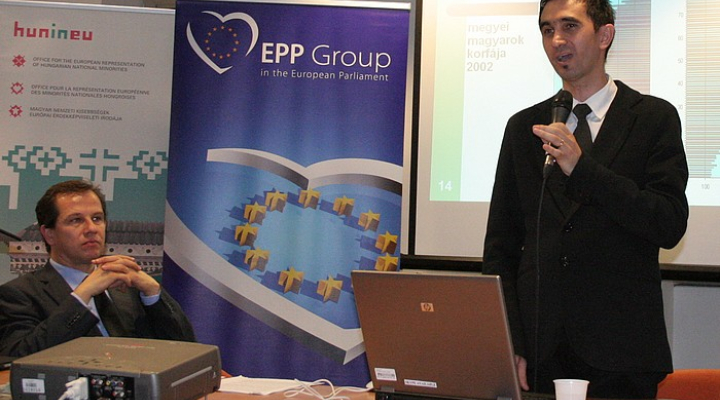Hungarians from Transylvania show the lowest level of ethnic assimilation
At the invitation of DAHR’s MEP Csaba Sógor sociologist, associate professor at the Babeș-Bolyai University and director of the Hungarian Institute for Sociology and Social Work, Valér Veress held two presentations in Brussels; one on the 26th of November at the HUNINEU office and the other on the 27th of November at the meeting of the Hungarian EPP Delegation.
The researcher analyzed ethnic assimilation in Transylvania as an issue of identity change from the perspective of mixed marriages, the education system, the census and the natural decline of the population. He spoke about the phenomenon of mixed ethnic marriages, the relationship between education and assimilation, as well as assimilation and ethnic identity. His conclusions included methods for curbing assimilation, as well as social and cultural action plans.
Even though there is no actual set of criteria for measuring the level of ethnic assimilation in the Carpathian Basin, the most positive sense of ethnic identity can be seen in the Hungarian community living in Transylvania. This is the place where relations between the majority and the minority are most well-balanced, and despite the constant decline in population numbers, this is the place where the level of ethnic assimilation is the lowest. This can be explained by the fact that Transylvania shows an inclusive attitude towards mixed ethnic marriages.
The negative aspects of the minority status become advantages in the positive appreciation of Romanian-Hungarian relations. The sociologist mentioned quality education, inner migration and special advantages as means of creating a positive social identity and as points of break-out from the phenomenon of ethnic assimilation.
The level of decline of the Hungarian population differs from region to region, but it is constantly lower than the Romanian average. The results of the 2011 census showed that the Hungarian community lost almost 200,000 people – said Valér Veress responding to the audience’s questions.
Host Csaba Sógor asked Veress to predict the number of Hungarians in Romania in 2050. The sociologist replied that the sudden drop in nativity has stabilized in the Hungarian community and due to the effect of democracy in Romania there will be a fairly stress-free environment, so even with the slow decline of the population, there will be almost to one million Hungarians in Romania at that time.
Even though there is no actual set of criteria for measuring the level of ethnic assimilation in the Carpathian Basin, the most positive sense of ethnic identity can be seen in the Hungarian community living in Transylvania. This is the place where relations between the majority and the minority are most well-balanced, and despite the constant decline in population numbers, this is the place where the level of ethnic assimilation is the lowest. This can be explained by the fact that Transylvania shows an inclusive attitude towards mixed ethnic marriages.
The negative aspects of the minority status become advantages in the positive appreciation of Romanian-Hungarian relations. The sociologist mentioned quality education, inner migration and special advantages as means of creating a positive social identity and as points of break-out from the phenomenon of ethnic assimilation.
The level of decline of the Hungarian population differs from region to region, but it is constantly lower than the Romanian average. The results of the 2011 census showed that the Hungarian community lost almost 200,000 people – said Valér Veress responding to the audience’s questions.
Host Csaba Sógor asked Veress to predict the number of Hungarians in Romania in 2050. The sociologist replied that the sudden drop in nativity has stabilized in the Hungarian community and due to the effect of democracy in Romania there will be a fairly stress-free environment, so even with the slow decline of the population, there will be almost to one million Hungarians in Romania at that time.











